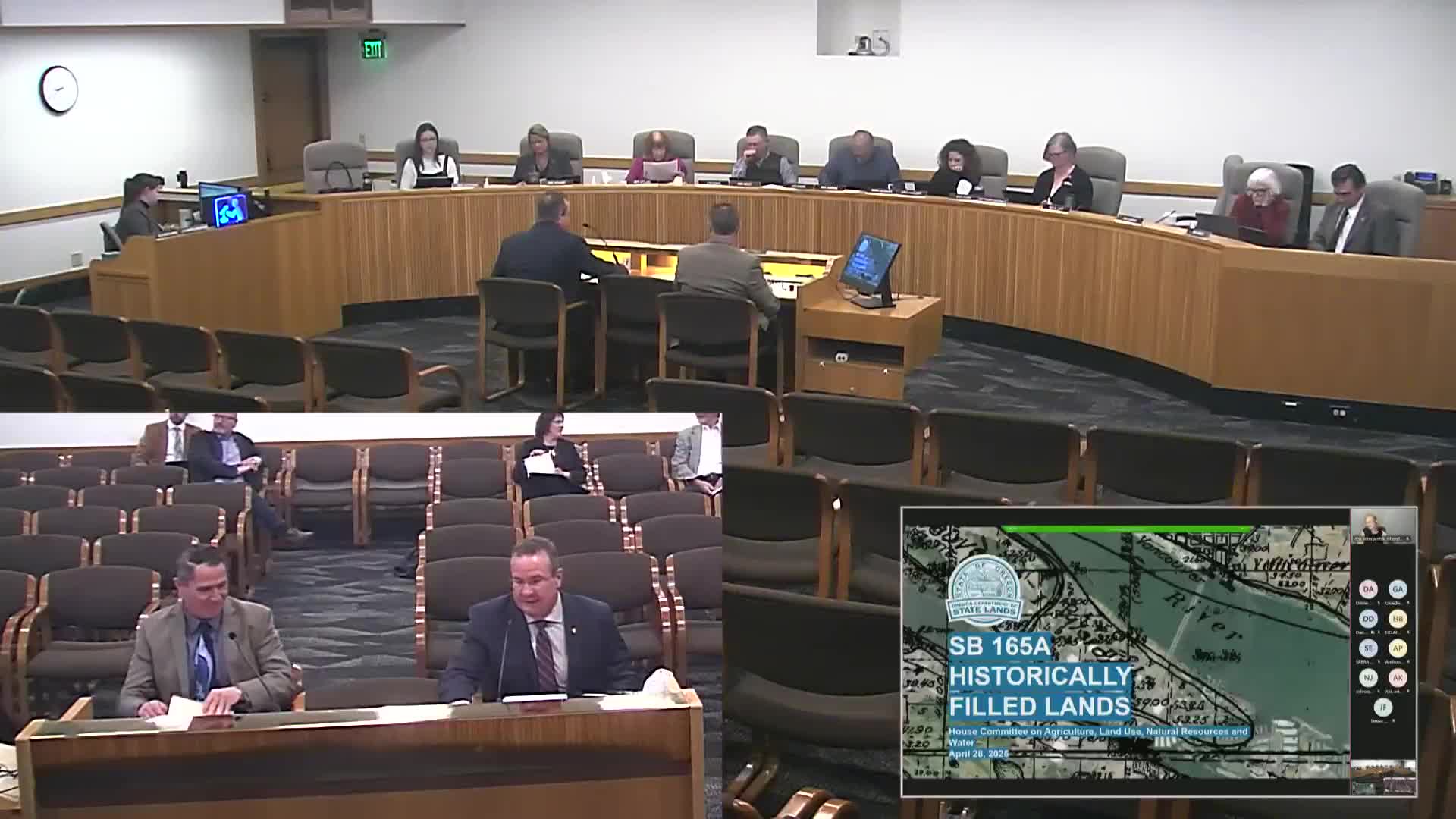Bill would limit state claims on historically filled lands outside key urban zones, DSL says
April 28, 2025 | Agriculture, Land Use, Natural Resources, and Water, House of Representatives, Committees, Legislative, Oregon
This article was created by AI summarizing key points discussed. AI makes mistakes, so for full details and context, please refer to the video of the full meeting. Please report any errors so we can fix them. Report an error »

Bill Ryan, deputy director of the Aquatic Resource Management Program at the Oregon Department of State Lands, and Chris Castelli, deputy director of the Land Management Division, told the Senate Committee on Agriculture, Land Use, Natural Resources, and Water on April 28 that Senate Bill 165 A aims to resolve long‑running uncertainty about ownership of historically filled lands.
"Clarity is the problem," Ryan said, summarizing the department’s view that unclear ownership creates clouds on title that impede sales and refinancing. He said many historically filled parcels identified by prior work were small, outside city limits and of limited revenue value, and that implementing the prior statewide identification process proved more costly than anticipated.
Under SB 165 A as described to the committee, the state would retain the ability to declare ownership only for historically filled lands within city limits that are zoned commercial, industrial, or marine industrial, and would be given until Dec. 31, 2028 to make those claims. The bill would remove the state’s authority to perform ownership determinations for other categories of filled lands going forward. The department said the change would include releasing state mineral rights on lands where the claim is removed, reducing split estate issues.
Castelli described background work by the Field Lands Advisory Group (FLAG) and the 2015 law (Senate Bill 912) that created a process and a 2025 deadline for state claims. He said DSL’s experience implementing SB 912 showed the process could be expensive relative to likely recoveries and that the department had resolved a small number of claims directly with property owners.
The department said the bill retains the option to pursue higher‑value, in-city parcels where public benefit may be greatest and noted Astoria’s waterfront was largely resolved by the Astoria Quit Claim Act of 1969. There was no fiscal note presented at the hearing; DSL said costs are expected to be absorbable within its current service-level budget and that some contract work (research, mapping, document recording) would be required to implement the narrower program.
Committee members had no further questions recorded at the close of the public hearing. DSL said it would continue to work with committee staff and stakeholders on implementation details and timelines.
"Clarity is the problem," Ryan said, summarizing the department’s view that unclear ownership creates clouds on title that impede sales and refinancing. He said many historically filled parcels identified by prior work were small, outside city limits and of limited revenue value, and that implementing the prior statewide identification process proved more costly than anticipated.
Under SB 165 A as described to the committee, the state would retain the ability to declare ownership only for historically filled lands within city limits that are zoned commercial, industrial, or marine industrial, and would be given until Dec. 31, 2028 to make those claims. The bill would remove the state’s authority to perform ownership determinations for other categories of filled lands going forward. The department said the change would include releasing state mineral rights on lands where the claim is removed, reducing split estate issues.
Castelli described background work by the Field Lands Advisory Group (FLAG) and the 2015 law (Senate Bill 912) that created a process and a 2025 deadline for state claims. He said DSL’s experience implementing SB 912 showed the process could be expensive relative to likely recoveries and that the department had resolved a small number of claims directly with property owners.
The department said the bill retains the option to pursue higher‑value, in-city parcels where public benefit may be greatest and noted Astoria’s waterfront was largely resolved by the Astoria Quit Claim Act of 1969. There was no fiscal note presented at the hearing; DSL said costs are expected to be absorbable within its current service-level budget and that some contract work (research, mapping, document recording) would be required to implement the narrower program.
Committee members had no further questions recorded at the close of the public hearing. DSL said it would continue to work with committee staff and stakeholders on implementation details and timelines.
View full meeting
This article is based on a recent meeting—watch the full video and explore the complete transcript for deeper insights into the discussion.
View full meeting
